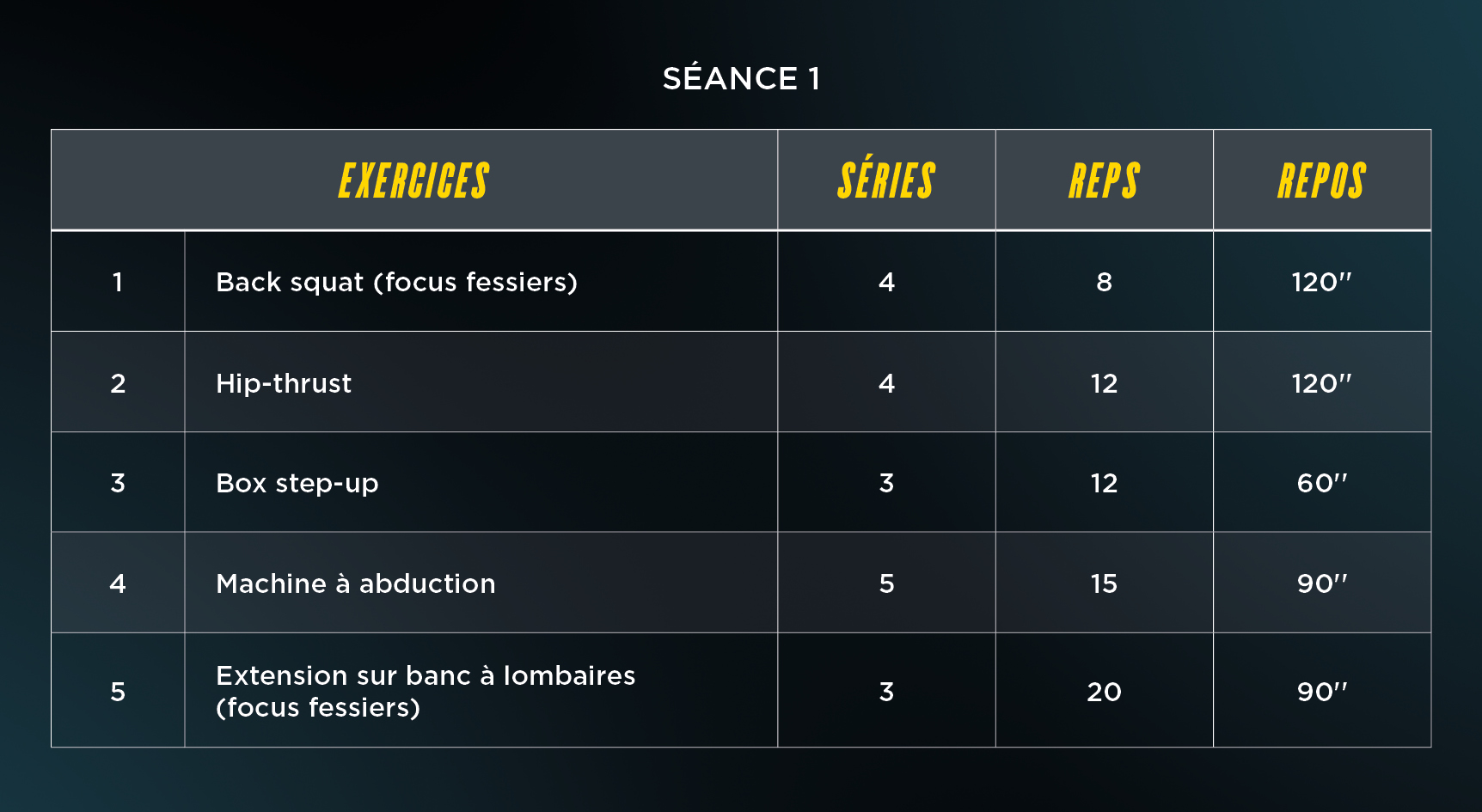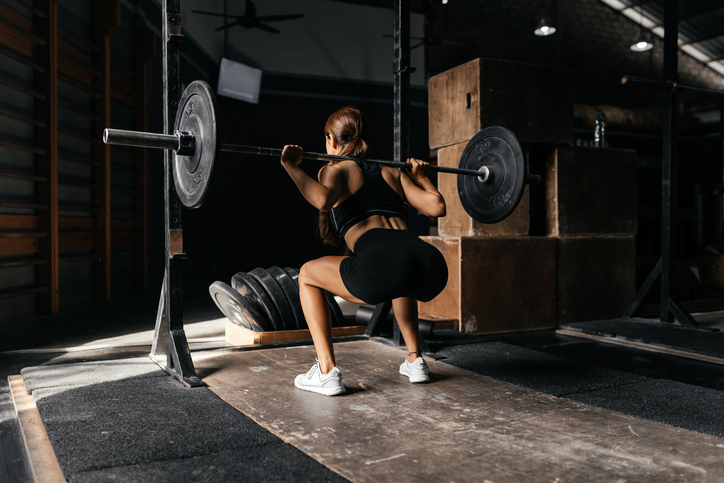Les 6 exercices pour muscler rapidement vos fessiers
Les vacances d'été approchent à grands pas et tu rêves d’avoir des fesses bombées, afin d’afficher une silhouette de rêve sur la plage. Tu veux raffermir cette zone si importante pour toi, mais tu ne sais pas comment t’y prendre. Tu as essayé plusieurs programmes sur internet qui promettent des merveilles, mais tout ce que tu as obtenu, c’est une perte de temps et des élastiques à ne plus savoir quoi en faire.
Aujourd’hui je te dévoile tout pour que tu obtiennes de jolies fesses musclées et rebondies !
Plus de promesses, que du concret !
Comment muscler ses fessiers ? Travailler les fessiers dans son ensemble
Avant de parler d’exercices ou de sport, un peu d’anatomie et de biomécanique s’imposent...Quoi, ça ne t’intéresse pas ? Je peux tout à fait comprendre, mais il est nécessaire que je t’explique comment sont constitués les fessiers et que tu comprennes à quoi ils servent pour savoir ensuite quels exercices choisir, dans le but d’optimiser leur entraînement.
C’est ok pour toi ? Parfait !
Alors déjà, il faut savoir que “le fessier” à proprement parler, est composé de 3 muscles :
- Le grand fessier (ou grand glutéal)
- Le moyen fessier (ou moyen glutéal)
- Le petit fessier (ou petit glutéal)
Travailler le grand fessier en priorité
Le grand fessier est le plus volumineux des 3, mais aussi le plus fort. Il se situe à l’arrière du bassin et c’est également la partie que l’on travaille principalement quand on cherche à galber le fessier, notamment à cause de sa grosseur et de son aspect “bombé”.
Le grand fessier a pour fonctions l’extension de hanche, la rotation externe de la jambe, la rétroversion du bassin et, dans une moindre mesure, l’adduction de la jambe.
Dans un but d’hypertrophie musculaire, l’extension de hanche (“ramener” la jambe vers l’arrière) reste la fonction la plus intéressante si tu veux recruter correctement ton grand fessier. Les autres fonctions ne sont que secondaires.
Raffermir les petits et moyens fessiers
Le moyen fessier se situe, quant à lui, sur le côté (partie externe) du bassin.
Il complète le grand fessier, en ajoutant du volume en largeur. Le moyen fessier permet principalement l’abduction de hanche (lever la jambe sur le côté). Ses fonctions secondaires sont la flexion de hanche (fibres antérieures) et l’extension de hanche (fibres postérieures).
Enfin, le petit fessier peut être vu comme le prolongement du moyen fessier, puisqu’il se situe plus légèrement sur la face antérieure du bassin. Au même titre que le moyen fessier, sa fonction principale reste l’abduction de hanche (lever la jambe sur le côté (ses fonctions secondaires étant la rotation interne de la jambe, la flexion de hanche ainsi que l’antéversion du bassin).
Donc, pour résumer, si tu souhaites construire des fesses galbées comme jamais, tu vas devoir choisir le sport et les exercices qui couvrent principalement les fonctions d’extension de hanche (grand et moyen fessier) et d’abduction de hanche (moyen et petit fessier).
C’est pour cela que je vais maintenant t’indiquer le sport qui recrute le plus les fessiers dans leur globalité !
Quel sport muscle le plus les fessiers ?
Alors, à ton avis ? Peut-être que la course à pied répond parfaitement à cette demande ?
Comme on a pu le voir tout à l’heure, il y a une bonne extension de hanche. Et si l’on prend plus précisément le sprint qui est un effort court et intense, il sera propice à la prise de muscle.
Ou alors l’équitation ? Les cavaliers sont constamment sous tension musculaire pour assouplir les impacts et garder un certain équilibre. Cette tension se reporte énormément sur les fessiers, ce qui en fait un sport parfait pour les muscler. Il y a aussi le ski alpin, qui exige également une très grande tension musculaire générale durant une descente…
La musculation est le sport privilégier pour des fesses galbées
D’après les activités citées précédemment, quel sport pourrait regrouper à la fois un effort court et intense, une grande mise sous tension et un travail isolé des grands fessiers ?
Je te le donne dans le mille : la musculation bien sûr ! À ce jour, ça reste le meilleur moyen pour favoriser l’hypertrophie de n’importe quel groupe musculaire.
“Mais dans ce cas, pourquoi je n’ai toujours pas de fessiers galbés, moi qui m’entraîne dur depuis X années ?”. Tout simplement car tu n’as sans doute jamais réellement compris le fonctionnement des fessiers. Tu les entraînais donc à l’aveugle !
L’ordre à respecter, si tu veux optimiser au maximum le développement d’un groupe musculaire, est le suivant :
1/ Comprendre ses fonctions principales
2/ Choisir les exercices appropriés
3/ Créer son programme
Si tu as bien suivi jusqu’à maintenant, nous en sommes à la 2ème étape : choisir les exercices appropriés.
Les 6 meilleurs exercices pour muscler ses fessiers
1. Deadlift (ou sumo deadlift)
Ce choix pourrait te paraître absurde et pourtant, il est totalement justifiable ! C’est personnellement l’un de mes mouvements préférés. Il peut se montrer redoutable sur le travail de la chaîne postérieure, grâce aux gains de force qu’il provoque.
L’utilisation des charges lourdes en fait un exercice parfait pour augmenter rapidement la tension mécanique, sur un groupe musculaire comme les fessiers. Ce dernier point en fait également un exercice dangereux, s’il n’est pas bien exécuté. Donc, prête toute l’attention nécessaire à ton exécution avant d’utiliser des charges lourdes.
2. Squat
Oui tu as bien lu : le squat pour muscler ses fessiers. :).
Mais attention, pour ce faire, une condition est requise : privilégier l’extension de hanche, tout en réduisant l’extension de genou. “Mais comment je fais ça moi ?”
Tu n’as tout simplement qu’à augmenter ta flexion de hanches, en augmentant l’inclinaison du buste sur ton mouvement, tout en gardant le dos droit (tu peux éventuellement augmenter l’écartement des pieds pour faciliter cette condition). Dans le même temps, réduis ta flexion de genoux. Cela engendrera automatiquement un étirement plus important des fessiers, qui optimisera alors leur recrutement.
Si tu as du mal à cibler tes fessiers malgré une exécution irréprochable, alors réalise ton squat sur une smith machine. En enlevant le facteur d’équilibre, elle permettra un meilleur recrutement des fessiers.
3. Hip-thrust
Un classique, qui a largement fait ses preuves.
Le hip-thrust est un excellent mouvement pour travailler les fessiers en contraction, ce qui en fait un des mouvements à privilégier si tu as du mal à les ressentir. Pour recruter au maximum les fessiers sans te blesser, je te conseille de garder l’alignement tête/colonne/bassin durant toute l'exécution. Je vois encore trop souvent des personnes qui réalisent une rétroversion en haut du mouvement (“bassin en avant”, “dos rond”) ainsi qu’une antéversion en bas du mouvement (“bassin en arrière”, “dos creusé").
4. Box step-up
Exercice que l’on voit de moins en moins mais qui pourtant, peut se montrer très efficace !
Son travail unilatéral renforce ta stabilité, réduit les risques de blessures et améliore donc ta capacité à prendre du muscle. Il permet également d’avoir une grande extension de hanche et favorise ainsi le travail des fessiers. L’idée ici est d’avoir l’intention d’écraser ton talon à l’intérieur de la box, en essayant de te focaliser au maximum sur l’engagement du fessier.
5. Glute kick-back à la poulie
C’est ni plus ni moins qu’une extension de hanche, réalisée à la poulie.
L’avantage majeur d’un tel exercice réside dans sa capacité à isoler le grand fessier (ainsi que les fibres postérieures du moyen fessier). S’il te manque du volume d’entraînement sur cette zone, tu peux éventuellement l’ajouter à ta programmation.
6. Machine à abduction
Et enfin, si tu souhaites isoler le moyen et petit fessier pour augmenter leur volume d’entraînement, tu peux opter pour ce genre d’exercice qui répondra parfaitement à ce besoin.
Cette machine est l’une des seules qui permettent un recrutement aussi ciblé du moyen et petit fessier, puisque d'abduction de hanches n’est pas un mouvement très “courant” en musculation.
Le programme d'entraînement ultime pour avoir un fessier galbé
Bon, puisque l’essentiel a déjà été dit, je vais te proposer 2 séances que tu pourras intégrer dans ta programmation d’entraînement. Tu pourras également t’en inspirer, si tu veux créer tes propres séances pour optimiser le travail des fessiers.


Durée de séances, fréquence d’entraînement…
Si tu incorpores les 2 séances, je te conseille de les réaliser qu’une seule fois chacune.
Le volume d’entraînement sur les fessiers est très élevé, tu auras donc besoin d’une récupération plus importante. Veille à avoir au moins un jour de repos entre chaque entraînement.
Peut-être que tu as décidé de créer ta propre séance, mais tu ne sais pas combien de séries tu dois attribuer aux fessiers ? Si tu veux un corps un minimum équilibré, tu devras programmer autant de séries sur les fessiers que sur les autres groupes musculaires. En revanche, si tu veux augmenter le développement de tes fessiers par rapport au reste du corps, le nombre de séries attribué aux fessiers devra être revu à la hausse.
Enfin, chaque séance devrait dans l’idéal ne pas dépasser 1 heure, pour maximiser le développement musculaire.
Conclusion
Tu as voulu un programme qui te permette d’obtenir un fessier galbé comme jamais ?
Te voilà servie ! Maintenant, entraîne-toi de façon intelligente, sois patient et les résultats pointeront le bout de leur nez d’ici quelques semaines !
 Offre spéciale : Les 4 premières semaines à 19€
Offre spéciale : Les 4 premières semaines à 19€




